
IN A HURRY? CHECK OUT Verizon Jetpack 4G LTE Mobile Hotspot TOP PROS:
A mobile hotspot is a portable device that allows a number of other devices such as laptops, smartphones, and tablets to connect to the internet wirelessly. The mobile wifi hotspot connects to the internet using 3G or 4G LTE signals from your cellular provider. If you have cell service, you will surely have the bandwidth to share. In this post, we’ll guide you through the best portable WiFi hotspots for international travelers.
Now the question arises, why get a WiFi hotspot when you already have a smartphone? Naturally, these types of devices are not for all people. A smartphone is enough for most of your internet needs because you can use it’s built-in tethering function to connect other devices in order to take advantage of the cellular signal. In other words, you can use your smartphone as a mobile WiFi hotspot. However, there are some drawbacks to this feature. First of all, your phone’s battery will deplete quite quickly, because of the extra energy being used to generate the hotspot. And lastly, you will most likely not be able to make or receive calls and text, because the hotspot will interrupt the cellular connection.
If your laptop needs internet access and it needs to stay connected in the fastest and most stable way possible, a mobile hotspot is an easy and reliable way of achieving this. As for which mobile hotspot to buy, that solely depends on the type of traveling you’ll do and the cell service you use.
CONTENTS:
- Before you Buy: Everything you need to Know about WiFi hotspots
- 4 Best WiFi Hotspots for International Travelers
- How We Choose These Products
| IMAGE | PRODUCT | DETAILS | |
|---|---|---|---|
 |
Our #1 Choice
Verizon Jetpack 4G LTE Mobile Hotspot – AC791L |
|
Check on Amazon |
 |
AT&T Velocity 4G LTE Mobile WiFi Hotspot |
|
Check on Amazon |
 |
Skyroam Solis |
|
Check on Amazon |
 |
Netgear Unite Explore 4G |
|
Check on Amazon |
Before you Buy: Everything you need to Know about WiFi hotspots
So, who needs a mobile WiFi hotspot? Well, 4G LTE networks are better than ever, and with 5G technology on the horizon, wireless web browsing can be faster than your home WiFi connection. Even though your smartphone can occasionally serve as a WiFi hotspot, cellular modems and WiFi hotspots are the best and most flexible options you have if you have a lot of devices you want to share internet access with.
Mobile WiFi hotspots can connect more than just laptops to the internet. They’ll also work just fine with tablet computers, cameras, and pretty much any other WiFi-enabled device. Depending on your hardware, plan, type of usage, nationwide connectivity for a fairly low price. However, you have to note that prices can run well over a hundred dollars per month if you want to use streaming services and download games.
Let’s go over everything you need to know in order to pick up the right service and device, along with the best WiFi hotspots on each service provider, and most importantly international options.
Should you wait for 5G service?
You’re about to witness some big changes in not just WiFi hotspot world, but in the cellular service world.
AT & T has launched the Netgear Nighthawk Fusion M5 hotspot in December of 2018. This is the first 5G hotspot in the US. Verizon is not far behind. They are planning on setting up the 5G network in April of this year. When it comes to Sprint and T-Mobile, things are still uncertain.
5G technology will be much more than 4G, and we hope to see truly unlimited data on 5G hotspot plans. One thing you should be aware of is that the coverage will initially be extremely limited. The system set up by AT & T will probably only work in the downtown areas of a dozen or so cities in the US. However, the race is on, and as 2019 transitions into 2020 you can expect to see 5G coverage to spread to most of the major cities and even the countryside.
If you need a mobile hotspot now, you shouldn’t worry. Cellular carriers will continue to expand and improve 4G coverage over the next five years. However, if you are looking to upgrade your existing hotspot with AT&T or Verizon, you can hold out for a couple of months and see what those 5G service plans will look like.
Mobile WiFi hotspots will never replace home internet!
If you are not a frequent traveler, wireless broadband isn’t for you. It costs more per megabyte than a home DSL or cable setup. WiFi hotspot plans range from “free” for 500 megabytes per month with FreedomPop on Sprint’s network if you buy a hotspot, up to 100 dollars or more.
The average US home DSL/Cable subscriber uses more than 190 gigabytes of data per month, mostly because of streaming services such as Netflix, Youtube, and Hulu. So if you are not planning on using your internet access on video or music streaming, a WiFi hotspot may be an alternative for your home. But if they do, you’ll become quickly frustrated by the data bucket limits. These restrictions on data are why you should be excited about 5G networks because they may feature truly unlimited data plans.
Who is using 4G? First and foremost, it’s the people who travel a lot and need reliable connections on the go that support multiple devices and don’t drain their smartphone batteries. Hotspot plans are an affordable alternative to dodgy hotel or convention hall WiFi, and they’re also more secure and reliable than public WiFi in bars and coffee shops. Vacation home and RV enthusiasts may also enjoy hotspots to light up their roaming, part-time houses. Small businesses that don’t use a lot of data may benefit from a WiFi hotspot.
Comparing Cellular Carriers
WiFi hotspots are available from all four nationwide carriers and even several virtual operators that rely on larger carriers’ networks.
Along with the major carriers, you sign up for hotspots from Boost, Consumer Cellular, FreedomPop, H2O, Karma, and Net10. You can expect to pay from 20 to 25 dollars per month for 2 gigabytes of data, 40 to 50 dollars for 5 gigabytes of data, and 50 to 90 dollars for 10 gigabytes of data. These rates only apply to the US, if you are planning on taking your WiFi hotspot abroad you better be prepared to pay a hefty penny.
Small virtual carriers offer low-volume prepaid plans which are best used for occasional use. If you are a light user, we recommend you sign up for Karma’s 13 dollars per gigabyte plan. If you are a heavy user, you can sign up for either T-Mobile’s or Boost’s 10 gigabytes for 50 dollars plans. One word of advice for heavy WiFi hotspot users, the best idea is to add your hotspot line to your existing carrier’s plan, as a separate line. That will get the most of the data for your money.
Please note that if you have an “unlimited” data plan, that will not carry over to your WiFi hotspot. If you add your hotspot to your unlimited plan, you’ll get anywhere from 15 to 50 gigabytes of high-speed data before you get kicked to the slow as snail speed. You should note that most cellular carriers throttle video streams in order to save on your data.
When it comes to the hotspot hardware, there is a tradeoff between the price and quality. The best hotspot hardware can be found on AT&T and Verizon. Smaller, more affordable carriers offer weaker, slower WiFi hotspot that, in most cases, don’t take advantage of new network features (like LTE).
The Best WiFi hotspot Hardware
Carriers around the world have been frantically upgrading their networks recently. Network capabilities have now overpassed the quality of hotspots running on them. This means that recent smartphones may get better speeds than WiFi hotspots do.
The best WiFi hotspots use the Qualcomm Snapdragon X16 or X20 modems. You will find these modes in the Netgear Nighthawk for AT&T and the MiFi for Verizon. The coolest thing about these modems is that they support every network feature. Hotspots from other carriers such as Sprint, T-Mobile, and other virtual carriers offer use three or four-year-old modems that have lower speeds and worse signal strength than recently smartphones. This means you may get from 5 to 10 megabytes per second, where your phone can achieve speeds from 25 to 30 megabytes per second.
High-end WiFi hotspots also feature a TS9 external antenna port to help you improve your signal using inexpensive antennas that you can easily find online. TS9 is a standard, and these antennas cost much less than a signal booster.
One thing you should keep your eye out for is WiFi hotspots that support 5GHz WiFi signals. These hotspots are usually faster and less congested than 2.4 GHz WiFi. Some WiFi hotspots also support guest networks and access controls such as MAC address filtering and time-based access controls. You can find these features on pretty much every dedicated home router, but you can’t take them for granted when it comes to mobile hotspots.
WiFi hotspots can also be used as backup batteries. However, not all of them come with this useful feature. If you want your future WiFi hotspot to serve you as a backup battery, you have to look for one that features a large capacity battery. There are other features you may find useful. For instance, some WiFi hotspots feature microSD card slots so you can use it as a tiny server to share media on their WiFi networks.
We personally really like displays on the front of a WiFI hotspot. Displays can report the strength of your signal, hotspot’s name, data usage, and the network password right on the device.
Different Types of WiFi Hotspots
Portable WiFi hotspots can be generally classified into three different categories:
- SIM card WiFi hotspot devices
- USB data card/modem based WiFi hotspot devices
- USB data cards with a WiFi hotspot option
Let’s go more in-depth about devices in these three categories.
SIM card based WiFi hotspot devices require you to buy a separate SIM card from an internet service provider or a cellular provider and insert it into the WiFi router. After you’ve inserted the SIM card, you will need to connect the router to your computer using a USB cable and configure it to use the said card in order to establish a connection with the service provider. Once you’ve configured it and established a connection, you can disconnect it for your computer and use it as a WiFi router. Pocket WIFi routers act as modems as well as WiFi hotspots.
USB data card/modem based WiFi hotspots, require you to have a USB based data card in order to connect to the internet. You will have to plug in the USB data card to the Pocket WiFI router and turn it on in order to establish a connection to the internet. In order to configure the initial settings, you will have to connect the data card using a USB cable and access the admin panel using your web browser. This type of WiFi hotspot devices don’t have a built-in modem, they rather depend on the USB data card to connect to the internet service provider. The only role of the WiFi router is to act as a WiFi hotspot to share the internet access wirelessly.
USB dongles/data cards with WiFi hotspot option eliminate the need to buy another device to share your internet. In most cases, these type of devices will serve their purpose. By using a single USB data card (in other words a WiFi Dongle) for internet and for WiFi sharing, you can save money because you won’t have to buy a dedicated portable WiFi hotspot.
If you take a closer look at these devices, you will easily figure out that the SIM card based hotspot devices and USB data cards with WiFi hotspot capabilities are pretty much the same types of devices, although they differ in appearance. They offer the same features such as connecting to the internet using a SIM card and sharing the internet over the WiFi. However, in most cases, the USB data cards are locked to a particular internet or cellular service provider, and you will not be able to replace the SIM card to connect to another service provider. In case of SIM card based WiFi hotspot devices, you will be able to replace the SIM card and connect to the internet using any service provider. These type of devices are excellent for international travelers because they allow you to purchase a SIM card from a local internet or cellular service provider and connect to the internet avoiding the overpriced data roaming plans.
So which is better – SIM card based WiFI hotspots, USB data card WiFi hotspot or USB dongles with a WiFI hotspot feature?
If you are a frequent traveler, we recommend you go for a SIM card WiFi hotspots because they offer quite a few advantages such as:
Small size that makes it very convenient to carry it in your backpack or pocket.
Even though they are bigger in size when compared to a simple USB data card, their slightly bigger rectangular shape makes them easier to handle and harder to lose.
You can easily replace the SIM card anytime and use any supported SIM card from any provider. Most USB data cards are locked to a specific internet or cellular service provider, and you will not be able to connect to another service provider when you travel to other countries.
Most USB dongles require to be connected to the USB port on your computer which makes them rather difficult to handle, and there is always a risk of you breaking them while moving. Portable WiFi hotspots do not require to be connected to your computer. Instead, you can connect them to any power source like AC power, the USB port in your car, cigarette lighter source in your car and so on. While driving, you can simply plug it into the USB drive in your car and enjoy internet access. If you are sitting in a restaurant or a bar with your friends, you may plug it into a power source in the restaurant and share internet access with everyone at your table.
However, there is an advantage to hotspot devices that use USB data cards. Because people use USB based dongles for personal internet connection, it’s very easy to borrow one from your friend and connect it to your WiFi hotspot to share internet access. Borrowing a SIM card to use it for sharing internet access may not be that easy!
Factors to consider when buying a WiFi hotspot
There are quite a few factors you need to consider before you go out and opt-in for a device that perfectly suits your needs. These factors go far beyond the form factor of the said device, which we’ll get into right now.
Locked or Unlocked WiFi hotspots
This is the most important factor to consider. If you are purchasing a very cheap WiFi hotspot, there is a very high chance that it’s locked to a service provider. If you purchase a locked WiFi hotspot, you will not be able to use it with any other service providers, which means that you will have to use their overpriced data roaming plans if you plan on traveling abroad. Because of this reason, we strongly recommend you buy a hotspot that is unlocked so you’ll have the freedom to switch the provider whenever you want or when the circumstances call for it.
Data Plans
If you are buying a locked WiFi hotspot, check the data plans that the internet service provider offers. Do they offer any prepaid plans, or do they offer only postpaid plans? Do they charge an arm and a leg for the plans? Sometimes, internet or cellular service providers will offer the WiFi hotspot at a very cheap price, but you will be bound by their service contract and have to use their expensive data plans. Not to mention their sometimes ridiculously priced data roaming plans.
How Many Devices You Want To be Connected at a Time
Before opting in for a particular WiFi hotspot model, check how many devices can be connected to it at the same time. Most models allow up to 5 connections which is reasonable enough. However, if you are planning on traveling with a group of friends that exceeds this magical number, you would want to look for a device that allows for a higher number of simultaneous connections.
Compatibility with Service Providers
It is extremely important to think about the service provider you are going to use most of the time. Not every internet or cellular service provider will have coverage in all areas you are planning to visit. Also, not every WiFi hotspot will be compatible with all service providers. Before you go out and purchase a WiFi hotspot, check if it is compatible with the SIM card, USB data card and the service provider you are planning to use.
Power Use
Many WiFi hotspots support multiple power sources such as USB power (from your car, computer, etc) and direct AC power. We suggest you opt for a device that comes with both a USB and an AC power inputs so that you can connect it anywhere and use it without having to connect it to your computer.
Rechargeable Battery
Not every WiFi hotspot features a rechargeable battery. It is extremely important to pick a device that features a rechargeable battery because that is what makes the device truly portable. With a built-in rechargeable battery, you will be able to take your WiFi hotspot anywhere and just turn it on to get access to the internet without having to search for a power source. This is even more important if you are planning on visiting places that don’t have any power outlets like beaches and campsites. One other awesome thing about Wifi hotspots that feature a rechargeable battery is that you can use them to charge your other devices such as smartphones, tablets, MP3 players and basically anything else with a micro USB port. However, you should keep in mind that that will drain the battery of the hotspot rather quickly which means that you won’t be able to connect to the internet.
Benefits of having a WiFi hotspot
If all this is still a bit confusing, here are some benefits of having a mobile WiFi hotspot:
You can connect multiple devices: Some mobile WiFi hotspots let you connect up to 10 or more devices, which will work out a lot cheaper than paying for a mobile data plan for each individual device.
You can connect WiFi-only devices to a mobile data connection. What do we mean by this? Well, tablets are great for use at home, but what about on the train, on the beach while camping? Wherever you can get a phone signal, you can use your WiFi hotspot to create a wireless network and connect to the internet from any WiFi device.
You can save money for your next tablet. Buying a tablet that features a 4G data connection add quite a bit of money to the price, and before you factor in the monthly fee for your data plan. You can use some of that money to buy a mobile WiFi hotspot instead, and you’ll never have to buy a 4G tablet computer again, nor will you have to base your purchasing decision on whether a cellular option is even available.
You can reduce your roaming charges. Cellular service providers offer free roaming in some countries. For instance, US-based cellular service providers offer free roaming in Mexico and Canada, while EU based providers offer free (but fixed) data roaming in all member countries of the EU. What you can do is connect all your devices to your mobile WiFi hotspot rather than paying an extra charge for all your individual devices. This way you will pay the roaming charge only ounce, and you’ll even save money.
You will avoid using snail speed hotel WiFI. There are still some hotels that charge you for WiFi access, and it’s usually ridiculously overpriced. You can get kids online all day and at a lower price than what one of these hotels would charge. Even more, you will avoid using the same network that all other guests are using, which is usually slow and frustratingly unstable.
You can add 4G connectivity to a 3G device. If you are still using a smartphone that only supports 3G, a mobile WiFi hotspot will significantly speed up your phone’s internet connection.
You can get faster download speeds. Even if your device already supports 4G connectivity, you could potentially get faster download and upload speeds by switching to a mobile WiFi hotspot that supports a faster connection. This will particularly be true when 5G connectivity gets finally introduced.
You can share storage across your own WiFi network. If you get a mobile WiFi hotspot that features a microSD slot, you can share that storage across all devices that are connected to it. This is especially handy if your devices do not support expandable storage.
To Tether or Not To Tether, That is the Question Now!
If you decide to make the jump, WiFi hotspots and cellular modems aren’t your only option. Almost all smartphones have integrated “wireless hotspot” functionality that let them connect to other devices via WiFi network. Most top-of-the-shelf data plans now include hotspot use. However, some service plans will require you to pay extra. This is an excellent solution for occasional use, but because it drains your smartphone’s battery at lightning speeds, this isn’t an all-the-time solution.
Data Roaming Will Cost You a Pretty Penny
Planning on traveling soon? US hotspots usually allow for data roaming in Canada and Mexico. Although rates may be pretty high, you should check with your carrier in advance to find out. For short trips further abroad, you can rent the Roaming Man U2 hotspot, which features LTE connectivity in most places. Unfortunately, it’s pretty hard to find an unlocked WiFi hotspot with global LTE bands in the US (this is true for the EU too), so if you want to fo the route where you buy a local SIM card to take advantage of much lower data rates, your best choice is to use the hotspot function on your smartphone.
Best WiFi Hotspots for International Travelers
Now that you know basically everything there is to know about WiFi hotspots, you can take a look at our list where we showcase the best models that you can opt for. We’ve taken great care at showcasing devices that support data roaming or are unlocked so which allows you to insert a SIM card from the country you are planning on visiting.
1. Verizon Jetpack 4G LTE Mobile Hotspot – AC791L
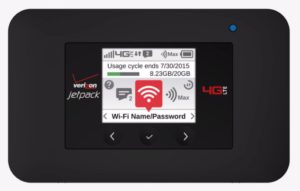
The Verizon Jetpack 4G LTE Mobile Hotspot AC791L from Netgear i one of the best mobile hotspots out there. It represents a significant improvement on their JetPack MiFi 6620L thanks to a more powerful battery, and the ability to charge other devices. Add Verizon’s XLTE network and a strong selection of global roaming bands, this device is an excellent option for business users in both the US and abroad.
One thing you should keep in mind about this WiFi hotspot is that it is not meant to be your home internet connection. The plans are on the pricey side and are geared toward business users who travel a lot. If you want to use the JetPack as a standalone device, Verizon’s mobile broadband plan gives you 5 gigabytes of data for 50 bucks a month or 10 gigabytes for 80 bucks a month.
When it comes to the form factor, the JetPack AC791L is small and quite sturdy. It measures 4.3 inches in height, 2.7 inches in width, and 0.8 inches in diameter which is small enough to fit in your pocket. It weighs 5.8 ounces, which is a bit bigger than the MiFi 6620L, but that doesn’t make it cumbersome to carry. Its casing is built out of smooth matte black plastic with rounded edges and features a 1.77-inch TFT LCD touchscreen. All navigation is done via the touch options with only the power button being a physical one. You can boost the signal thanks to the two TS9 connector pins that sit at the bottom of the device. For power, the JetPack utilizes a 4340 mAh battery that can also power your smartphone!
When it comes to the WiFi signal, the JetPack is able to transmit both 2.4 and 5 gigahertz signals which is awesome because some older devices don’t support the latter frequency WiFi. You can also set up the VPN on the device if you are worried about Verizon spying on your data.
The coolest thing about this device is that it supports not only the Verizon’s network in the US but also networks from over 200 countries. This means that this WiFi hotspot is an excellent choice for those who are constantly on the go. The only drawback to data roaming is that it only supports quad-band EDGE and HSPA connectivity so you won’t be able to stream HD movies and music.
Pros
- Lightweight and sturdy
- Supports data roaming in over 200 countries
- Outstanding battery life
- You can boost the WiFi signal with up to two TS9 antennas
Cons
- When in data roaming you are limited to EDGE and HSPA connectivity
Bottom Line
The Verizon JetPack AC791L is an excellent mobile WiFi hotspot if you are looking for a device that offers lots of battery life to get you through long work days. If you own a MiFi 6620L, there is no reason to get this device, but if you are looking for a brand new hotspot, the Jetpack is an excellent choice for you!
2. AT&T Velocity 4G LTE Mobile WiFi Hotspot
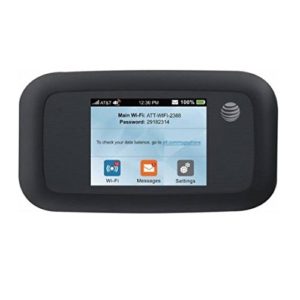
The AT&T Velocity 4G LTE Mobile WiFi Hotspot represents a slightly more affordable half of their mobile hotspot duo thanks to ditching some of the features the provider offers with the Unite Pro. The Velocity offers excellent performance that will be more sufficient for most users. This WiFi hotspot is excellent for those who are looking for a device that can support up to 5 devices at one time.
With the smaller size and softer lines, the Velocity is a bit more pocket-friendly than its boxy Unite Pro counterpart. Measuring 4.5 inches in width, 2.5 inches in height and 0.7 inches in diameter, you can easily carry it both in your pocket or in your backpack. The combination of glossy plastic and metal accents give it a slightly less professional look than the Unite Pro, but that is one of the concessions AT&T made in order to make this device more affordable. On the top edge of the Velocity, you will find a microSD slot, along with the WPS and power buttons. The bottom of the device features a SIM card slot and the always useful reset pinhole. Unfortunately, there are no external antenna ports.
The Velocity features a 2.4-inch touchscreen display which is serviceable at best. It is not very bright, and the input is laggy. The UI itself is a bit tiny and hard to navigate, but after a couple of days of use, you will get the hang of it.
If you are not tech savvy, you don’t have to worry because this device requires no setup out of the box. The Velocity will automatically connect to the AT&T’s network and display its WiFi SSID, password and data usage. When it comes to the WiFi signal, the Velocity defaults to 2.4 GHz WiFi but you can set it to broadcast at 5GHz as well.
When it comes to data roaming, it is available in most major countries such as Canada, Mexico, Australia, the UK, and others. Unlike our top pick, you will be able to take advantage of LTE connectivity in other countries as long as there is coverage. Not only that, but you can also use this device in over 250 international cruisers so you can take it with you to enjoy high-speed internet access while sailing the ocean.
Pros
- Quite Affordable
- Excellent battery life
- Compact
- Supports both 2.4 GHz and 5 GHz WiFi broadcasting
- Supports data roaming in all major countries and even ocean cruisers.
Cons
- The build quality of the device is iffy.
- The touchscreen is serviceable at best.
- There are no TS9 antenna ports.
Bottom Line
The Velocity is able to fulfill the needs of most users. If you are planning on going on a vacation and you need a stable internet connection to keep in touch with the folks at home and at your business, then the Velocity is an excellent choice for you. However, if you are a power user, you should opt for the more expensive Unite Pro device because it comes with more features, and offers a much longer battery life.
3. Skyroam Solis
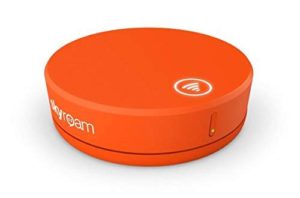
Skyroam’s latest mobile hotspot is specially designed to be your ultimate travel companion. The way the Solis works is by offering 9 dollar day passes for unlimited 4G LTE connectivity all over the world. It features a slim, hockey puck-like design and has a massive 6000 mAh battery for both power supply and as a power bank.
When it comes to coverage, the Skyroam Solis offers 4G LTE coverage in more than 110 countries across the Americas, Asia, Australia, Africa, and Europe. This device uses a virtual SIm card which means there is no physical SIM card inside it. You can simply turn on this hotspot and connect to the internet without any carrier integration or special hardware which makes things pretty convenient.
This minimalistic hockey puck-shaped WiFi hotspot measures 3.5 inches in diameter, 1 inch in height, and weighs approximately 5 ounces. Unlike other products offered by Skyroam, this WiFi hotspot doesn’t feature a screen or an interface. Instead, this device only has two buttons, on for the WiFi that also serves as the battery indicator, and the other for turning it on or off. The white LED ring around the WiFi symbol on the WiFi button gives you a basic indication of how much charge it is left. Both the WiFi and power buttons are a tad bit annoying because they don’t offer enough tactile feedback so you won’t know whether you’ve pressed them or not.
Registering your Solis device, activating day passes, and checking all other setting is achieved through a web interface. Once connected to the Skyroam WiFi network, you will have to go on their website to register and activate your WiFi hotspot device. Skyroam offers 20 minutes of free WiFi of registration only, so you don’t have to worry about not being able to register it when you’re somewhere where there is no internet access.
When it comes to roaming with this device, you are bound for a wild ride. The data speeds will range anywhere from a measly 0.25 megabytes per second, up to 41 megabytes per second. This is mainly caused by the vSIM software and the compatibility with the local cellular service provider. If you want to ensure this device outputs a stable connection, we recommend you stay in areas where the coverage is more than good which means city centers and high transit areas.
When it comes to the WiFi broadcast capabilities of this little device, you are limited only to 2.4 GHz band. This is not that bad if you plan on spending your time away from areas where there are lots of WiFi routers (read: the countryside), but keeping away from these areas will mean that you will experience an unstable connection to the carrier.
Pros
- The device is incredibly compact
- It features a massive 6000 mAh battery that also serves as a power bank
- Quite sturdy
Cons
- Slow and unstable internet speeds
- The buttons don’t offer enough tactile feedback
- The mobile/web interface can be glitchy at times
Bottom Line
While Skytoma Solis’ battery and charging capabilities are what set it apart, this device falls short in internet speed and stability. The Solis is an excellent choice for international travelers that don’t require high internet speeds, but still need some form of internet connection to do their business or keep in touch with their loved ones.
4. Netgear Unite Explore 4G
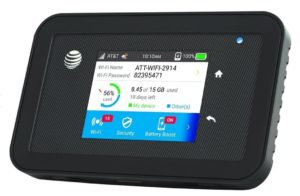
The Netgear Unite Explore represents everything you need in a mobile WiFi hotspot. In an era where every smartphone features a hotspot mode, the Unite Explore shows the battery, range, network, and signal advantages that more than justify getting a separate WiFi hotspot when you really need to share internet access with multiple devices.
The Unite Explore is a quite rugged measuring 4.5 inches in width, 2.8 inches in height, and 6.4 ounces in weight. It’s covered in rubber bumpers, it’s splash resistant, although not submersible. On the front of the device, there is a bright 2.4-inch touchscreen that allows you to quickly check the network name, password, data used, and the list of devices that are connected to it. The charging port, which also allows you to connect it as a USB modem, is a USB 3.0 port.
One of the key features of this device is located on the side: a pair of external TS9 external antenna ports. The device doesn’t ship with the antennas, but they are easily found on the internet. They can boost the dual-band (2.4 and a 5GHz WiFi signal at the same time) quite a lot, so you don’t have to worry about walking out of range.
This little brick also hides another cool feature: a removable 4340 mAh battery that lasts for up to 18 hours. This is more than three times most smartphones are able to manage. You can even use this device as a power bank in emergencies. Not only that, but it’s also GSM unlocked which means you are not bound to only one service provider. This is excellent for international travelers who want to avoid paying for data roaming services by simply inserting a SIM card for a provider based in a country they are currently visiting.
The Unite Explore utilizes the latest Qualcomm x12 modem to connect to the carrier. It also supports 3x carrier aggregation which knits together three different bands of the radio spectrum into a single wider highway for greater internet speeds and better stability. This WiFi hotspot supports LTE bands 1/2/3/4/5/7/12/17/29/30 and HSPA 850/1900/2100 which means it covers all types of connectivity currently available worldwide. Not only that, but the Netgear Explore supports OpenDNS for content filtering, segregated guest networks, scheduling, MAC filtering, VPN passthrough, DMZs, and IP passthrough for USB connections.
Pros
- Extremely rugged and durable
- Massive battery capacity
- Supports all frequency bands
- It’s GSM unlocked which means you are not bound to a single internet service provider
Cons
- It’s a bit pricey
- The touchscreen display is in low resolution
Bottom Line
The Netgear Unite Explore 4G WiFi hotspot is an excellent choice for any international traveler that doesn’t want to pay for data roaming plans, and wants to connect a whole lot devices at the same time. No other mobile WiFi hotspot offers this much connectivity options and an excellent battery life at the same time. Not only that but you can also thrash it around without fear of breaking it. Even though it’s a bit pricey for some, this device more than justifies its price.
How We Choose These Products
While compiling the list of products above we were mostly focusing on showcasing you the devices that offer the best possible international coverage. This goes for both the WiFi hotspots that are locked to a specific carrier and for those that are unlocked.
The second thing we were focusing on was on showcasing devices that are of decent build quality. Many WiFi hotspots that are available on the market are of very bad build quality and tend to break down quite easily if you mishandle them. That’s why we gave our best at finding you the devices that are able to withstand the punishment a traveling by plane, car, bus and boat.
Besides the build quality we were also focusing on showcasing you devices that are fairly easy to set up. We understand that not all people are tech savvy, and setting up a WiFi hotspot can cause them quite a bit of headache.
So, what do you think about WiFi hotspots? Should people opt for them, or are smartphones enough? Are you using any of the devices listed above? What do you think about our list? Let us know in the comments below!


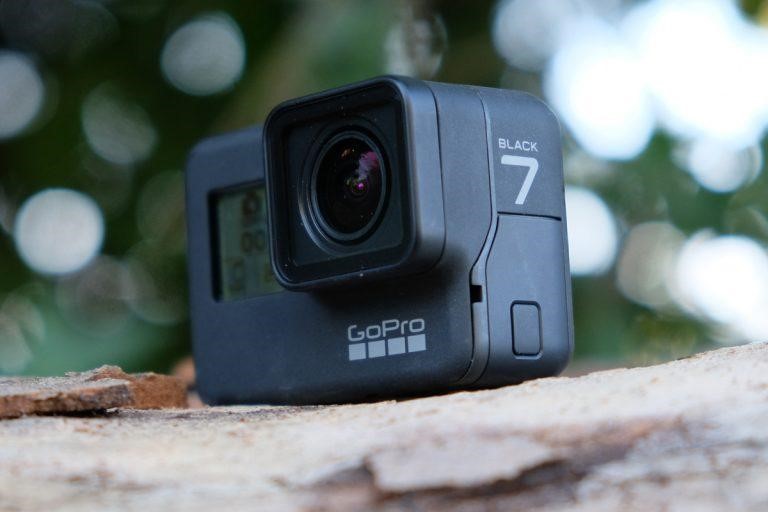

No Responses